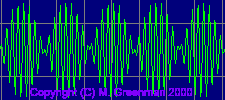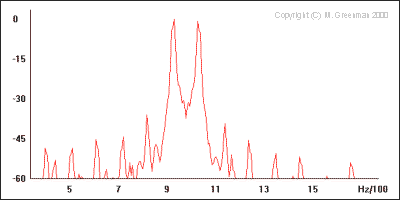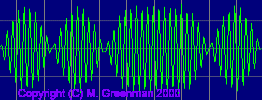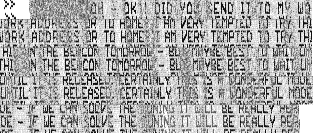PSK-Hell and FM-Hell
While Hellschreiber has been around now for about 70 years, few truly new ideas have been developed since
Hell's ground-breaking work. PSK-Hell and FM-Hell, developed in collaboration
between Murray ZL1BPU and Nino IZ8BLY, may be among the best of recent innovations.

PSK-Hell in 105 Baud mode
This page is about four different modes which are in many ways very similar. In fact, they all share the
same receiving technique (the quadrature demodulator, a type of phase detector). There are two different transmission techniques, PSK and MSK, and two baud rates used, 105 baud and 245 baud. Now immediately you will ask
"what happened to 122.5 baud used by Feld-Hell?". Well, in fact the
new baud rates are completely compatible, and we need to explain how this comes about.
| Hell Mode | Baud | Bandwidth | Speed
| Feld-Hell |
122.5 |
450 Hz |
25 WPM |
PSK105
FM105 |
105
105 |
105 Hz
55 Hz |
25 WPM
25 WPM |
PSK245
FM245 |
245
245 |
245 Hz
123 Hz |
25 WPM
25 WPM |
|
105 Baud
First consider the 105 baud modes, which were designed to keep the keying bandwidth to a minimum.
Each character of a PSK105 or FM105 Hell transmission is portrayed as a series of dots, in a matrix, just like Feld-Hell, but the matrix is only 7 x 6, seven columns of six dots (42 dots) rather than 7 x 7 (49 dots).
There must be an even number of dots per column to prevent unexpected dots between columns (this is explained later). This reduction in dots per column from seven to six allows a lower baud rate (105 baud) for the same 17.5 columns/sec column rate and text speed as Feld-Hell.
(105 = 122.5 x 6/7). The dots are sent one at a time, in the same order as Feld-Hell, but in a rather different way.
The most important point is that the rate at which the text columns are transmitted is the same
as for Feld-Hell, and although the bandwidth and text resolution are reduced, the mode is speed
compatible with other 122.5 baud modes. One other point to note is that due to the nature of the
modulation technique, the 'half pixel' trick used in Feld-Hell is not applicable. As you can see
from the above example, the text is certainly not as nice as a Feld-Hell 122.5 baud transmission,
but it is very sharp and noise-free. A special font is required.
245 Baud
Obviously a 245 baud mode will be twice as wide and could have twice the resolution of a 122.5 baud mode.
This is how full resolution is restored to PSK-Hell and FM-Hell modes. Once again the column
rate of 17.5 columns/sec ensures Feld-Hell compatibility - the font simply has 14 pixels/column instead of seven,
conveniently an even number again. There is no need for the 'half-pixel' Feld-Hell trick, as the full resolution and bandwidth of a 98 dot matrix are available. Standard Hell fonts and even Windows fonts
can be used, without any change in signal bandwidth!

PSK-Hell in 245 Baud mode (20m DX)
PSK-Hell
As with PSK31 and other PSK modes, the data in PSK-Hell is encoded in carrier phase, rather than
amplitude. Because it is never
possible to know the absolute phase of an HF transmission when it is received,
and the phase is continually changing because of ionospheric effects, it is not possible to define
white dots as one phase and black dots as another. Consequently, we use a technique called
Differential Phase Shift Keying (DPSK),
which relies on detection of a change in phase. At the beginning of each dot, the phase is reversed
if the dot is white, but not changed if the dot is black. The transmitted phase stays constant until the next dot.
Thus, the received signal phase need only remain approximately constant for one dot time, as it is only the
difference that is looked for, not the absolute phase. This makes the mode relatively insensitive to
random ionospheric phase changes (so-called 'ionospheric Doppler').
PSK-Hell is not able to send 'grey' dots (some Feld-Hell software renders characters with some grey - lower power - dots in order to approve appearance), nor is it able or required to send 'half pixel' dots. At 245 baud,
all dots are effectively 'half pixel'.
When switching the phase of a carrier, very strong keying sidebands can be generated, just as though
one transmitter was switched off instantaneously, and another of opposite phase was switched on. To avoid this problem
the transmitted signal is also amplitude modulated with a raised cosine, just as in the best Feld-Hell
systems, and in PSK31. This reduces the transmitter power to zero at the moment when the phase is changed.
Here's an oscilloscope picture of a string of white PSK-Hell "dots". Notice how the phase of each burst is different from its predecessor, and that the dots are carefully shaped.

PSK-Hell white dots
Each of these bursts is one pixel or dot. The tone frequency is 980 Hz, as used for Feld-Hell, and as you can see, the dots are completely identical, except every second one is flipped vertically, to provide 180� phase change. The shaping (called a raised cosine envelope) is used to reduce the transmission bandwidth. With this technique, the signal is only 105 Hz (or 245 Hz) wide, and in fact (see below) it has a spectrum consisting only of two carriers 105Hz (or 245 Hz) apart, spaced either side of 980 Hz. This raised cosine shaping is exactly the same as double sideband suppressed carrier modulation of a 980 Hz carrier with a 105 Hz (or 245 Hz) sine wave.
In the spectrum analyser picture below, the 980 Hz carrier is suppressed by about 40 dB, and the two
sidebands are obvious. Of course the carrier returns when black is sent. Without the shaping, the phase changes would cause numerous keying sidebands at 105 Hz spacing. In this picture from a real signal, you can see the keying sidebands every 105 Hz, at about 45 dB down, much reduced by the raised cosine shaping. These sidebands become much stronger if the SSB transmitter is overdriven.

105 Baud PSK-Hell Spectrum
The transmitter duty cycle is very high in PSK-Hell, about 90% (remember Feld-Hell transmits nothing to send 'white' dots!). The next picture shows three white pixels followed by a black pixel and a following white pixel. See how the phase does not change between the third white pixel and the start of the black pixel. Note also that the raised cosine modulation is not required as the black dot starts, because the phase does not change. This has the effect of decreasing the bandwidth during black dots, and also increasing the average power.

The problem of choosing a font for 105 baud PSK-Hell or FSK-Hell was tricky. The font
stores the dot colours, not the changes, so it is likely that some characters will have an even number of dots, while others will have an odd number of dots. Thus it transpires that any character following one with an even number of dots could end up having an inadvertent black dot sent at the beginning of the character, which you will see in the next picture, taken during the development process.

When the wrong font is used, random dots appear!
This has been solved by designing the font carefully, either using an even number of pixels per column, or providing for the phase of complete characters to be reversed where necessary. In addition, as inferred above, it is not possible in 105 baud mode to utilise the 'two pixel' technique
developed by Rudolf Hell. This trick provides for double the resolution without doubling the bandwidth, by sliding the pixels in time by one half dot. Unfortunately this would not only increase the bandwidth in PSK-Hell, but would make it difficult to send an even number of dots. The answer to this problem is to use 245 baud to provide the necessary resolution for the sharp high definition fonts.

245 baud PSK-Hell
Because of the raised cosine modulation, it is very important for PSK-Hell to be amplified and transmitted linearly. Otherwise the signal will become very broad. When well adjusted, the signal is a very creditable 105 Hz wide.
FM-Hell
The obvious problem with using 245 baud is that the signal is consequently wider (but still narrower than Feld-Hell or RTTY). During the development
of 245 baud PSK-Hell, it was soon realised that it could be received just as well with one of the sidebands nulled
or filtered out. To prove the point, an "SSB-PSK-Hell" mode was tested and found to be very effective.
After exploring the mathematics of signal generation, it was realised that the same signal could
be generated using an FSK technique combined with careful control of phase, essentially Minimum Shift Keying (MSK). This is not only less
processor intensive, but requires less filtering as the signal is very clean.
Instead of a sudden change of phase to indicate a white dot, there is a smooth change of phase
through the pixel. The frequency is shifted without any sudden phase transitions, until the required phase change has been achieved.
The result is FM-Hell, a type of MSK, and it is possible to transmit 245 baud
FM-Hell with a shift as low as 50 Hz. The sensitivity is however best if a shift of 122.5 Hz is used.
There are several advantages to FM-Hell:
- The transmission is narrower than PSK-Hell and Feld-Hell
- Full resolution is maintained, and high resolution Windows fonts are no wider than Hell fonts
- Raised cosine modulation is not required to control keying sidebands, so the transmission is constant power
- Since the signal is constant in amplitude, a linear transmitter is not required
- There appears to be less blurring of DX transmissions than PSK-Hell or Feld-Hell.

245 Baud FM-Hell
Compare this picture with the previous one (they were recorded during the same contact under the same
conditions, and of course with the same receiving technique). Notice that the blurriness obvious on the PSK-Hell sample is completely absent in the FM-Hell
sample. We believe the reason is that in PSK-Hell, although the phase rotation caused by the ionosphere
affects both sidebands equally, the timing changes that result do not, and the PSK-Hell signal is the sum of
two signals placed slightly differently. FM-Hell can instead exhibit a slight wavering of the text up and
down, as happens with Feld-Hell, but this in no way impairs reception.
Performance
Much the biggest advantage of PSK-Hell and FM-Hell, like any PSK mode, is sensitivity. The advantage over Feld-Hell in noise is probably of the order of 6 - 8 dB. The following comparative examples shows 105 baud PSK-Hell and Feld-Hell received at about 0 dB S/N and about -12 dB S/N, in a 3 kHz noise bandwidth. FSK-105 is about equivalent, and 245 baud modes about 3dB worse.

PSK-Hell 105: 0 dB S/N (left) and -12 dB S/N (right)

Feld-Hell: 0 dB S/N (left) and -12 dB S/N (right)
Here are some further comparisons, this time real DX signals on 14 MHz, from the same contact under the same conditions. Note the fading on the Feld-Hell sample, and the clarity of the FM-Hell sample. No change in transmitter power, antennae (dipoles) or receiving setup - only a mode change. By the way, the 245 baud FM-Hell signal is narrower than 122.5 baud Feld-Hell!

Chris HB9BDM transmitting 122.5 Baud Feld-Hell

Chris HB9BDM transmitting 245 Baud FM-Hell
In practice, the 245 baud modes perform about as well as the 105 baud modes, since the increased resistance to Doppler, and the better font resolution tend to compensate for loss of sensitivity.
PSK-Hell and FM-Hell are much less affected by impulse noises (such as lightning) than Feld-Hell. This is because the dynamic range of the receive software
(identical for both modes) is huge, and the receiver AGC need not fully recover before copy is restored. In the next enlarged example, copy is lost briefly due to two local lightning strikes, and the signal continues to be copied between the strikes!

PSK-Hell demonstrates excellent lightning tolerance
This example is from a QRP contact over 18,000 km on 14 MHz, and copy is remarkably good. The horizontal stripes are caused by the PSK-Hell raised cosine modulation, and become more obvious when the signal is weak. As you can imagine, PSK-Hell and FM-Hell are not much affected by fading. The timing changes of multi-path signals that usually accompany fading can be a problem, although perhaps a bit less so that on Feld-Hell. This is mostly a problem on lower bands, particularly 80m. Here's a comparative example of signals with severe multi-path.

Multi-path simulation - PSK-Hell (left) and Feld-Hell (right)
This is a simulation, created by adding a 20ms delayed signal 4 dB weaker than the main signal. This makes for poor copy, but is not unusual on 80m! PSK-Hell and FM-Hell are reasonably immune to interference, particularly pulse noise and hash, but can be badly affected by on-frequency carriers or Morse. When the signal is very weak, it is likely to suffer significant interference by stations who do not recognise it or realise the signal is even there!
The most significant effect that can really ruin PSK modes for DX is that of ionospheric Doppler. Where the ionosphere is in a state of constant change, the ion density can change quite quickly, and therefore so also does the propagation speed and refractive index. As a result, signals passing through such areas (most marked near the earth's magnetic poles) undergo quite significant velocity modulation. This causes amplitude, frequency and phase modulation of the signal. Provided the signals occupy reasonable bandwidth, this may not be a problem, but very narrow band signals (like PSK-31) suffer quite badly from polar flutter, which can easily introduce phase noise on the signal that exceeds the signal bandwidth, resulting in zero copy. Differential PSK data modes such as PSK31 are badly affected because the change in phase can easily exceed 180� within one bit time.
PSK-Hell and FM-Hell are protected from this problem in two ways - first, the dot time is much shorter than PSK-31 (9.5 ms or 4.8 ms rather than 32 ms), and secondly, the receive process does not use clock recovery to determine when to sample each data bit. As a Fuzzy mode, the PSK-Hell/FM-Hell receiver samples at a constant (quasi-synchronous) rate, typically four times the transmitted dot rate, and the phase noise tends to create a background noise level that is averaged by the eye and does not affect copy.
One interesting feature of Doppler flutter on PSK-Hell (which can sometimes also be seen on Feld-Hell) is the effect of Doppler on the phase of the received characters - PSK-Hell and FM-Hell can cope with about �25 Hz of Doppler shift without losing copy (shown in the simulation below), but with this much shift, the text is moving up and down, like waves on the ocean:

The effect can quite often be seen on real signals, such as this QRP transmission from VK2DSG on 80m, received in New Zealand:

Making waves with PSK-Hell

The world's first PSK-Hell DX QSO
Reception on 20m in Europe is notoriously noisy. The above picture is from the world's first PSK-Hell DX contact on 21 Aug 1999, and show reception (in Europe) of ZL1BPU by IZ8BLY, at a range of about 18,000 km. Both stations were running 10W output to dipole antennas. The QSO was at about 0600 UTC, and would probably have been long path, i.e. through the north polar region.
The image above is not touched up in any way, and the text clarity is typical of this range. (Thanks to Nino IZ8BLY for the picture).
Copyright � Murray Greenman 1997-2009.
All rights reserved. Contact the author before using any of this material.
















